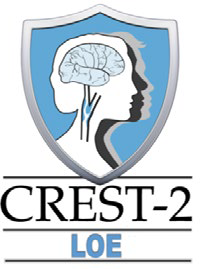 CREST-2 (clinicaltrials.gov number: NCT02089217) is a pair of parallel, actively recruiting procedural trials to prevent stroke comparing: 1) carotid endarterectomy (CEA) and intensive medical management (IMM) to IMM alone, and 2) carotid artery stenting (CAS) and IMM to IMM alone. CREST-2 is designed to have ≈3-year average follow-up (maximum, 4 years). 2,480 patients will be randomized. C2LOE is an observational follow-up of the patients who “graduate” (i.e., pass the 4-year follow-up point in CREST-2). It is a highly cost-efficient, centralized process involving telephone and telehealth visits and review of medical records to monitor for stroke endpoints and home health visits to monitor control of vascular risk factors after patients graduate from CREST-2 to assess rigorously the transferability and real-world long-term effectiveness of intensive medical management with or without carotid revascularization. Our proposed long-term observational extension (LOE) is significant regardless of the CREST-2 results. If revascularization fails to show superiority (i.e., if IMM-only treatment is superior or not significantly different), proponents of revascularization will argue that the average follow-up was not sufficiently long to document the benefit of the procedure. Written consent on all CREST-2 patients will be obtained for continued follow-up for an additional 5 years, providing a 7.5-year average follow-up, with a subset of patients followed to >10 years. Cost-effectiveness will be achieved through innovative follow-up methodology. Our approach is also designed to minimize patient burden and maximize retention. The primary aim of this proposal is estimation of post- procedure treatment differences between revascularization and IMM vs. IMM alone. The currently funded CREST-2 trial will provide data on post-procedure treatment differences up to ≈3 years. Extending follow-up will enable us to assess whether post-procedure benefit is maintained during intermediate (4-6 years) and long-term follow-up (7-10 years); thereby, testing durability. The primary outcome for the CREST-2 LOE is the composite of stroke and death within 44 days after randomization and ischemic stroke ipsilateral to the randomized vessel thereafter. Our LOE approach is significant because it can be applied to a wide variety of stroke prevention trials where the therapeutic intervention is a device or procedure.
CREST-2 (clinicaltrials.gov number: NCT02089217) is a pair of parallel, actively recruiting procedural trials to prevent stroke comparing: 1) carotid endarterectomy (CEA) and intensive medical management (IMM) to IMM alone, and 2) carotid artery stenting (CAS) and IMM to IMM alone. CREST-2 is designed to have ≈3-year average follow-up (maximum, 4 years). 2,480 patients will be randomized. C2LOE is an observational follow-up of the patients who “graduate” (i.e., pass the 4-year follow-up point in CREST-2). It is a highly cost-efficient, centralized process involving telephone and telehealth visits and review of medical records to monitor for stroke endpoints and home health visits to monitor control of vascular risk factors after patients graduate from CREST-2 to assess rigorously the transferability and real-world long-term effectiveness of intensive medical management with or without carotid revascularization. Our proposed long-term observational extension (LOE) is significant regardless of the CREST-2 results. If revascularization fails to show superiority (i.e., if IMM-only treatment is superior or not significantly different), proponents of revascularization will argue that the average follow-up was not sufficiently long to document the benefit of the procedure. Written consent on all CREST-2 patients will be obtained for continued follow-up for an additional 5 years, providing a 7.5-year average follow-up, with a subset of patients followed to >10 years. Cost-effectiveness will be achieved through innovative follow-up methodology. Our approach is also designed to minimize patient burden and maximize retention. The primary aim of this proposal is estimation of post- procedure treatment differences between revascularization and IMM vs. IMM alone. The currently funded CREST-2 trial will provide data on post-procedure treatment differences up to ≈3 years. Extending follow-up will enable us to assess whether post-procedure benefit is maintained during intermediate (4-6 years) and long-term follow-up (7-10 years); thereby, testing durability. The primary outcome for the CREST-2 LOE is the composite of stroke and death within 44 days after randomization and ischemic stroke ipsilateral to the randomized vessel thereafter. Our LOE approach is significant because it can be applied to a wide variety of stroke prevention trials where the therapeutic intervention is a device or procedure.
- Centralized long-term telephone follow-up surveillance for stroke events among patients “graduating” from the CREST-2 randomized trial who were initially recruited from 130+ clinical centers in 5 nations
- 2480 patients
- Clinicaltrials.gov website: https://classic.clinicaltrials.gov/ct2/show/NCT05465122